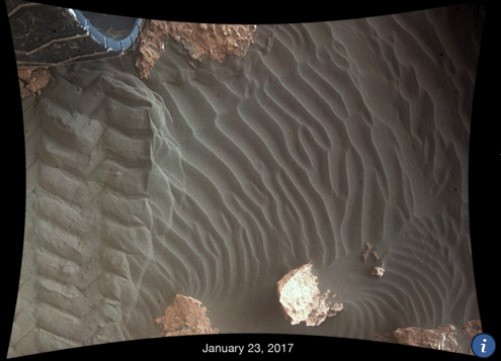By Ana Verayo, | March 02, 2017

This image shows effects of one Martian day of wind blowing sand underneath NASA's Curiosity Mars rover on a non-driving day for the rover.
NASA mission scientists suggest that winds on Mars have shaped Mount Sharp, which is the tallest mountain found inside Gale Crater. New observations from NASA's Curiosity rover on Mars have revealed new imagery and data about this iconic Martian mountain.
Despite the atmosphere on Mars being 100 times less thin than on Earth, it is still dense enough to produce weather systems like clouds and winds. NASA scientists suggest how these are the driving forces that shape Martian landscape.
Like Us on Facebook
In addition to Curiosity rover's observations, data from NASA's Mars Reconnaissance Orbiter reveal how Martian winds have been transferring dust and sediment out of Gale Crater for as long as 1 billion years. This in turn left behind dust and rock layers that formed into as high as 3.4 miles, creating Mount Sharp.
Gale Crater measures 96 miles across and was created from a massive asteroid impact that crashed into the surface of the Red Planet some 3.6 billion years ago. The crater was also host to river and lake systems that later formed rock, sand and silt deposits into the basin, filling it entirely.
As Mars' climate became drier, the wind eventually resulted in the erosion these sediment deposits in the crater. NASA mission scientists first theorized that the tall mound found in the center of Gale Crater was a remnant formed via wind erosion and that the basin was originally full of mud, soil and silt.
In this new study, new data suggests how much material disappeared because of this erosion which is estimated to around 15,000 cubic miles. This data is also consistent with the orbiter's wind observations on the Red Planet's crater, that has been estimated by multiplying this amount over billions of years.
During 2015 and early 2016, the Curiosity rover explored a group of sand dunes during the summer season on Mars, which is also the most windy season as well. According to Nathan Bridges from the Johns Hopkins University Applied Physics Laboratory who is also part of the NASA Curiosity mission team, these linear dunes reveal sand movement thus forming a ribbon pathway. This ribbon can oscillate back and forth and from side to side.
To date, the Curiosity rover is studying the movement and composition of sand particles of these linear dunes, which are located at the lower slopes of Mount Sharp. Most recent imagery taken by the rover reveals sand ripples moving an inch downward. In addition Curiosity also captured images of whirlwinds known as dust devils that are moving within the crater.
According to Curiosity project scientist Ashwin Vasavada of NASA's Jet Propulsion Laboratory, Curiosity will be busy in this sandy region on Mars since there's a lot of wind activity around the crater. We want to learn more about the effect of winds blowing around the surface of Mars that reveals clues about the formation of dunes, mountains and ancient sandstones.
-
Use of Coronavirus Pandemic Drones Raises Privacy Concerns: Drones Spread Fear, Local Officials Say

-
Coronavirus Hampers The Delivery Of Lockheed Martin F-35 Stealth Fighters For 2020

-
Instagram Speeds Up Plans to Add Account Memorialization Feature Due to COVID-19 Deaths

-
NASA: Perseverance Plans to Bring 'Mars Rock' to Earth in 2031

-
600 Dead And 3,000 In The Hospital as Iranians Believed Drinking High-Concentrations of Alcohol Can Cure The Coronavirus

-
600 Dead And 3,000 In The Hospital as Iranians Believed Drinking High-Concentrations of Alcohol Can Cure The Coronavirus

-
COVID-19: Doctors, Nurses Use Virtual Reality to Learn New Skills in Treating Coronavirus Patients







